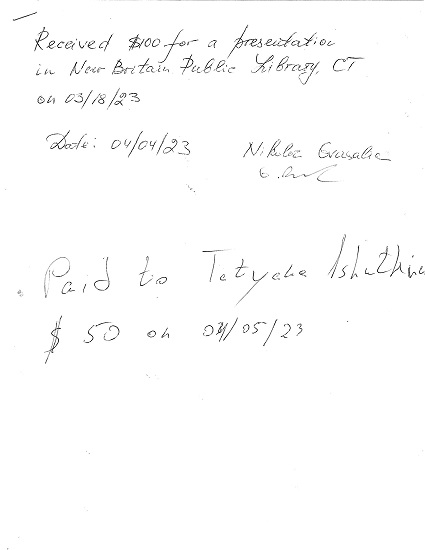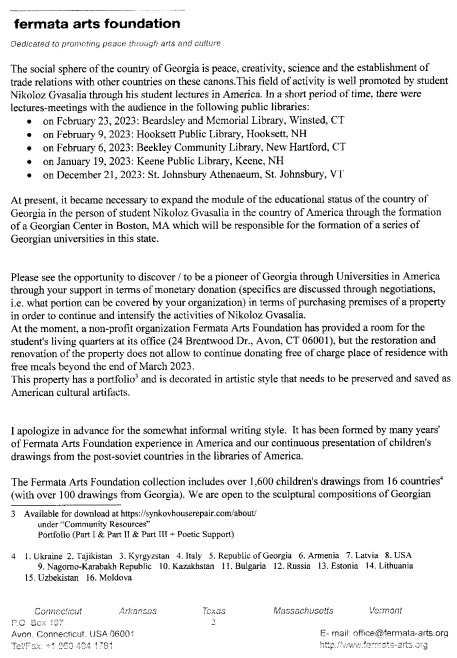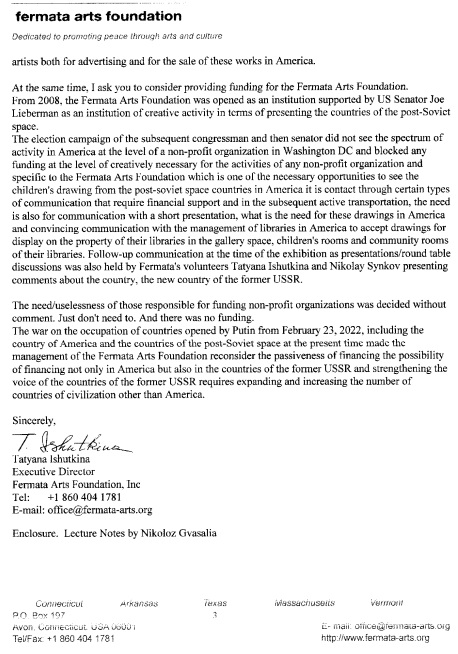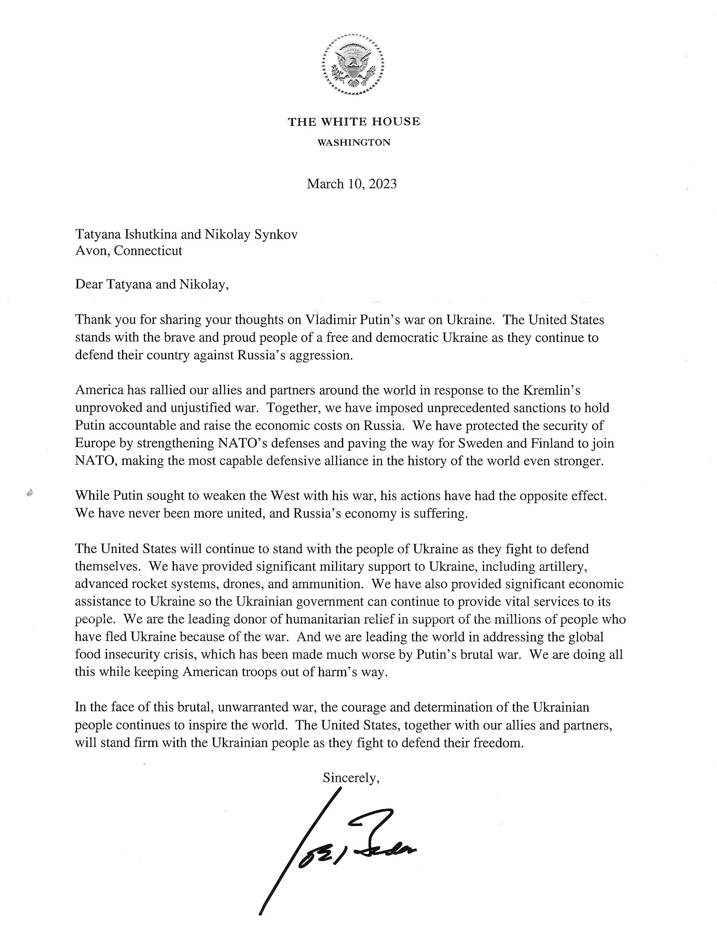April 7, 2023. Topic Zelenskyy’s CORRUPTION initiated instead of innovation: Zelenskyy’s Shipbuilding = HQ of Shipbuilding with patent content. Office clerks didn’t serve. (by SCHWIPAR Centre for Innovational Development)

April 6, 2023. Topic Zelenskyy’s CORRUPTION initiated instead of innovation: Transport of Zelenskyy – military plane rank of president (criminal) to a meeting with … . (by SCHWIPAR Centre for Innovational Development)
4/6/2023 Entry Two The theme of Day 50Stand in front of me like a horse in front of grass – Zelenskyy in the office of the US President Pay is not for me – Zelenskyy
Yesterday, April 5, the US Secretary of State, Anthony Blinken, published the list of sanctioned persons, which included Georgian judges, representatives of the so-called clan of judges.
Sanctioned judges have been working in the judicial system since the time of the previous government. We remind you that the reason for the collapse of the previous government was the unjust court and biased judges. After the change of government, there was a hope in the society that new transparent judicial reforms would be launched. But soon it became clear that the change of the government would not be accompanied by systemic changes, the judges who justified the extremely biased decisions of the previous regime are now not in prison, but are still sitting in their positions.
Corruption law, unfortunately, is an integral part of us and the country lives in the background of such injustice. I consider very correct the measures taken by the American State Department that these judges will be accepted as undesirable persons for the American government. I would like to point out that the history of these judges is a clear example that the change of the government does not mean the change of the corrupt system. In my opinion, there are many similar precedents, especially in former Soviet countries, such as Ukraine. It is very important to conduct the fight against the massive machine of corruption, step by step and effectively, because the corrupt nature of state structures has led to the worst socio-political situation that we see today in Eastern Europe.
4/5/2023 Entry One The theme of Day 50Stand in front of me like a horse in front of grass – Zelenskyy in the office of the US President Pay is not for me – Zelenskyy
For more than 30 years, in the center of the capital of Georgia, people who were kicked out of their homes live in extreme poverty and unbearable social problems. Each of their days begins with the thought that somehow they will feed their children and make it to the next day. Generations are growing up who have no idea where they come from and what their homeland is like. The government is unable to provide for them, so the IDPs have to rely only on themselves.
Earlier, when they were new IDPs, they were waiting for the end of the war and they hoped to return to their homes in a few months. This hope has existed for 30 years, and although the home no longer exists, the new generation is afraid of the future because there is nothing to see. The bright future seems dark to them because they see nothing bright in the future. They do not enjoy New Year and other holidays, because pyrotechnics are often used on such events. Fireworks and the sounds of explosions are associated with them as the horrible hellish past that forced them to live in a foreign environment, and every day turned into a test.
No matter how many decades pass, they will remain refugees in another country and another city and will never be at home. The indigenous inhabitants of the city always perceive them as strangers and will not allow them to be like them.
Unfortunately, we have a similar black-and-white picture in Eastern Europe today, where oppressed refugees are trying to cope and adapt to their new environment.
Sadly, we consider explosives more important than people. It is a tragedy that our news starts with the war and not with the presentation of the evacuation of the civilian population.
How many more social crises must happen to realize that America is not a country of refugee presidents, but of refugee people?
People who have seen war, humiliation, and hunger are not strangers to me, I grew up with them and know them very well. I sincerely believe that one day, America will recognize them, and welcome them with open arms.
Wars are won by those who manage to help the most people, everything else is geography and politics.
4/4/2023 Entry Five The theme of Day 49:Turn it off. Turn it off. I’m telling you Turn it off – the tanks are over – Germany. Remained – stand up, all victims of oppression….
The name “Georgia” is assumed to be derived from the Greek word georgos, which means land in English.
Ancient sources confirm that agrarian culture has been relevant in Georgia since time immemorial, of course, partly thanks to the fertile land, but it is worth noting the level of development of ancient Georgian metallurgy, which allowed the population to work more productively. Along with the general discussion, it is worth noting the important role of vines in Georgian culture. Vineyard is a symbol of life for Georgians. And the nectar of the grapes is the blood of Christ, which must not be wasted under any circumstances. It is thanks to Georgian farmers and winemakers that Georgian culture has been mummified and reached us. Even during the invasion of the merciless enemy, Georgians still managed to harvest the holy fruits. Perhaps it is not surprising that there are about 500 grape varieties in Georgia, it is Georgia that is considered the homeland of wine because traces of ancient wine production have been found here, which is 8000 years old.
National Georgian Ballet is an integral part of Georgian culture. However, it has nothing to do with ballet you know. In Georgian ballet, the main movements are based on the old fighting style, and the style of dances, and directly conveys the history of Georgian fighting ability. Along with battle scenes, Georgian national dances also include wedding dances. This dance is called Georgian and it represents two couples in love. During the dance, the woman expresses tenderness and honesty, during the whole dance the woman shyly looks down and tries to avoid eye contact with the man, and on the other hand, the man shows his masculinity in a posture of strength, at the same time, during the whole dance, the man does not have the right to touch the woman, thus he Shows respect to women.
Kolkhuri “White” is one of the first coins issued on the territory of Georgia, these artifacts clearly show us how developed blacksmithing was in the territory of ancient Georgia. It is worth noting the traditional Georgian weapon production culture. Since the country was constantly fighting for self-preservation against the biggest empires, it was necessary to start creating a military industry. Along with the production of weapons, there are ancient fortresses in the mountainous regions of Georgia, which were the only means of protection for ordinary families.
As I said earlier, Georgia converted to Christianity in the 4th century, and religion played a huge role in Georgian culture, and religious conversion ultimately shaped the country’s political course and made it a target for many enemies. Fortunately, the monuments of orthodox architecture still stand on the territory of Georgia. Georgian traditional temple architecture is a unique example in the entire Christian world, a similar style of temple architecture can be found only in Georgia and Armenia. Scientists assume that the influence on religious architecture in the Caucasus comes from the ancient Mesopotamia region, where ancient religious chapels were discovered as a result of archeological works. The buildings of these ancient civilizations have a lot in common with the Caucasian churches, first of all, the pointed dome is noticeable, this symbol denotes the aspiration to heaven and endless life.
The symbol of Georgian individualism is the Georgian alphabet, which is one of the 14 world scripts. For the first time, traces of Georgian writing are found in Palestine and it dates back to the 30s of the 5th century.
The 11th-12th centuries are considered to be the golden age of the Kartli state. At that time, education reform was actively underway in the country, many schools and monasteries were built, the country’s territorial size covered the entire region, and Georgia became one of the leading states in Eastern Europe. All this started in the 11th century, thanks to King Davit Agmashenebeli, who, thanks to the military reform, was able to defeat the Sejuks, the strongest state at that time, in the Battle of Diddgori in 1121. And Georgia finally flourished under his granddaughter, Queen Tamar. It is the twelfth century that is associated with the creation of the epic Georgian poem “The Knight in the Panther’s Skin”, which was created by the Georgian poet Shota Rustaveli. An interesting adventure in the poem, takes place in ancient Persia, although it is easy to see analogies with Georgia, especially when the main idea in the poem is about the reign of women. Scientists think that Shota Rustaveli was secretly in love with Queen Tamar and dedicated his epic poem to her.
At the end of the 12th century, the first precedents of democratization appeared in Georgia, the rulers of the country considered creating a state council, which would be similar to the current parliament, but the project was not implemented, and the Spanish Cortes was considered the first European parliament.
The ethnically diverse population in Georgia has always been sheltered under its wing. Jews have been living in our country for three thousand years. It is a matter of pride that this is perhaps the only nation and country that has never had anti-Semitic sentiments, and next to the main cathedral of the capital of the country, there is a Jewish synagogue, a Muslim Mosque, and Ateshgah of fire worshipers. Several Persian chronicles also write that our people do not feel as well at home as in Georgia, because foreign merchants and travelers paid fewer taxes than Georgians themselves.
The ethnic diversity of Georgia is best expressed in Tbilisi, the capital of Georgia.
The Middle Ages, unlike the Renaissance of Western Europe, turned out to be quite difficult in the Caucasus, Georgia in the 16th century was already disintegrated, it could no longer resist the enemies from the east: first, the permanent raids of Temur Lang//Tamerlane, then black and white Turkmens, then the Safavids//Kizilbashur Iran, and finally the fall of the Byzantine Empire in 1453 from the west and the revival of the mighty Ottoman Empire cut it off from Europe. All these factors led to the fact that Georgia was divided into principalities, and the principle of a unified state was lost.
In the 18th century, Georgia’s self-goal was the European choice, but the only solution for a weakened and disintegrated Georgia was to change its political orientation in favor of its Christian northern neighbor, Russia. Finally, the Russian Empire conquered Georgia in the 19th century, soon abolished the centuries-old autocephaly of the Church, and then began a 200-year struggle for independence.
At the beginning of the 20th century, the Russian Empire began to disintegrate, and the revolution of 1917 finally overthrew Tsarism. It was the best chance for Georgia and the local government of Georgia at that time, On May 26, 1918, Georgia declared its independence, and on February 21, 1921, the Constitution of Georgia was adopted, which was one of the most democratic and progressive European constitutions of that time. Unfortunately, the country’s independence lasted until 1921, and the country became a victim of Soviet Russia, and in 1922 Georgia became one of the socialist republics.
During the Soviet occupation, the industry was actively developing, in particular, such industries as the electric power industry, mechanical engineering, fuel and ferrous metallurgy, and light and chemical industries. Agriculture was also at a fairly high level. Georgia was not inferior to the leading positions in the field of viticulture. Meat and dairy cattle breeding and meat and wool sheep breeding flourished. The network of railways and roads within the Georgian SSR was actively developed. It was during the Soviet period that Georgia became a popular region in the development of domestic tourism. The main Georgian sea resorts of Batumi and Sukhumi were visited by residents of other republics of the USSR with enviable regularity.
Despite these many positive factors, Georgia remained a prisoner of the communist machine, which mercilessly tried to erase individualism and independent culture from the consciousness of the Georgian people. Fortunately, even in these difficult years, some people tried their best to preserve the national identity, and even during the period of totalitarianism, they tried to present the Georgian spirit in the form of art. One such person was Merab Berdzenishvili, a Georgian sculptor and artist, the author of many unique works, his outstanding sculptures kept the sadness and anger of Georgian history.
When talking about the history of Georgia in the 20th century, we must mention, arguably the most famous Georgian in world history, this person created his era, and he was the ruler of the greatest state of new and recent history, this man is Joseph Stalin.
Stalin was born in the small town of Gori in Georgia on December 21, 1879, his real name is Josep Jugashvili, Stalin is his pseudonym, which was named after him due to his strength of character, Stalin means steel in Russian. Stalin created his image, or cult of personality, which probably resembles the most egregious absolute monarchy, the dictator’s role in history is still relevant.
For part of society, he has been associated as the creator of a bloody regime that mercilessly and for no reason killed millions of people in work camps, human life for him and individualism had no price. And for many, he remains a hero to this day, having defeated Nazi Germany and allowed the Soviet Union to stand on the side of the twentieth-century super-state, as Winston Churchill said, He came to the Soviet government with a sickle and leave it with a nuclear weapon.
Both opinions are acceptable, because in both opinions there are historical facts and events, although the most interesting and objective is probably the opinion of an ordinary citizen living
at the time, who saw the period of his rule.
In 1991, after the collapse of the USSR, Georgia again became an independent state. 70 years from 1921 to 1991 are considered the time of the “Soviet occupation of Georgia”. Modernity In the period from 1990 to 1992, the country was under the leadership of President Zviad Gamsakhurdia, under whom market relations were introduced in Georgia. The leadership of Zviad Gamsakhurdia didn’t last long. in January 1992 Gamsakhurdia was removed from his post and left the country. in March 1992 announced the creation of the State Council.
In general, we can say that in the 90s, Georgia was an unorganized state, ruled by gangsters and corrupt officials.
The situation began to improve after 2003 when Mikheil Saakashvili came to the head of the country as a result of the Rose Revolution, the current course of the country is uniquely Western, and during these years Georgia has achieved a lot in terms of democratization.
Unfortunately, the Russian government, dissatisfied with the European development of Georgia, started a war against Georgia in 2008, and in the end, as a result of the war, 20 percent of the country is occupied by the Russian army.
In December 2018, Salome Zurabishvili, the first woman president in the history of independent modern Georgia, became the President of Georgia. This is the shortest excursion into the history of Georgia.
April 4, 2023
ENTRY SEVEN:
I am returning $100 for a process of presenting Georgia, a multi-age country, in the New Britain Public Library, New Britain, CT on March 18, 2023. They are on a table with a receipt for you to sign.

4/4/2023 Entry Six The theme of Day 49: Turn it off. Turn it off. I’m telling you Turn it off – the tanks are over – Germany. Remained – stand up, all victims of oppression ….



4/4/2023 Entry Four The theme of Day 49: Turn it off. Turn it off. I’m telling you Turn it off – the tanks are over – Germany. Remained – stand up, all victims of oppression ….

4/3/2023 Entry Three The theme of Day 49: Turn it off. Turn it off. I’m telling you Turn it off – the tanks are over – Germany. Remained – stand up, all victims of oppression ….
Hello, my name is Nikoloz Gvasalia, I am a student at Tbilisi State University, and today I will try to introduce you to the country in which I was born and raised.
You probably have a question, what is Georgia and why is this strange little country named after one of the American states?!
The truth is that Georgia is a diverse, ancient country located between Europe and Asia, in a small region called the Caucasus.
The flag you see now represents the red or bloody, difficult past, while the white is a symbol of a bright future and hope.
The large cross in the center of the flag represents Georgia, and the smaller crosses around it are the four apostles who were the first to preach Christianity in Georgia in the 4th century.
These apostles were Andrew, Simon the Canaanite, Matati, and Saint Nino. As you may have guessed, the Orthodox Christian religion plays a major role in the life of Georgia.
In general, the Caucasus region, despite its small size, is distinguished by its diverse nature and the culture of the local people. Imagine, in this small region, the area of which is not larger than the state of Indiana, there are up to 40 languages! The richness of nature is added to the linguistic diversity, there are permanent alpine zones, straight valleys, deserts, exotic forests where citrus fruits flourish, and, of course, a beautiful seaside.
Georgia, thanks to its geographical location, was considered a strategic territory since ancient times, the section of the greatest silk road passed through the territory of Georgia. Almost all military campaign routes coincided with the location of Georgia, which played a big role in shaping the cultural diversity of Georgia.
The manifestation of the identity of any culture begins with clothing. Georgian traditional clothing, also known as chokha, is first found in Georgian sources of the 9th century. Historians suggest that the history of Georgian traditional clothing begins in ancient Persia, and later it was remodeled in the Caucasus and turned into much more stylish and comfortable clothing. Chokha very well expresses the tough spirit of the Caucasus, and at the same time, it places the role of military clothing in history.
Georgia is no less interesting, with the factor of prehistoric times. It should be noted that it is in the territory of South Georgia that the first homo-sapiens outside of Africa were discovered. By the way, it was this event that created the racial term Caucasian. Archaeologists found ancient artifacts in the small village of Dmanis, they traced the remains of the skulls of two individuals, and later they even found out their sexes, it turned out that one was a woman and the other was a man, and they were given Georgian names, Zezva and Mzia. And later it turned out that Mziya is a man, although he kept the name of a woman.
We learn about the first Georgian states from the ancient Mesopotamian sources of the second millennium before Knariste’s Christmas.
In the territory of eastern Georgia, Iberia, and the territory of western Georgia, Kolkha. In turn, both states were quite powerful at the time, according to ancient Greek sources, the kingdom of Colchis was known for its high quality of metallurgy and high level of education, even Herodotus, the father of history, writes about this in his book called History.
In the famous mythology about the Argonauts, the events take place right in the territory of Kolkheti. According to mythology, the brave Argonauts go through the most difficult obstacles during their sea journey and finally find themselves in Colchis, where the golden fleece belonging to Zeus is kept. After completing the tasks of King Aetius of Colchis, the Argonauts try to take the fleece to Greece, although the king intended to kill them. Fortunately, Medea, the king’s daughter in love with the leader of the Argonauts, decided to help them and eventually managed to sneak the Argonauts quietly into the night with the Golden Fleece.
4/1/2023 Entry Two The theme of Day 49: Turn it off. Turn it off. I’m telling you Turn it off – the tanks are over – Germany. Remained – stand up, all victims of oppression ….
Although it is impossible to predict what will happen in the ongoing crisis on the EU-Belarus border, likely, these events will further accelerate the process of building walls and passing fences in Europe, which has already begun.
We may soon see a new “Iron Curtain” come down, dividing the continent once more. And while it no longer stretches “from Stettin on the Baltic to Trieste on the Adriatic,” as Winston Churchill put it in his legendary speech in 1946, new barriers are likely to arise in more and more places, dividing EU members from non-members.
The EU is currently trying to respond to Alexander Lukashenko’s most cynical plot against the West – bringing thousands of migrants from the Middle East, especially Iraqi Kurds, into the country, busing them to the borders of Latvia, Lithuania, and Poland, and inciting them at the border to find their way to the EU.
Sanctions are likely to be imposed that will affect Belarusian airports, various transport companies, and people responsible for these migration flows.
